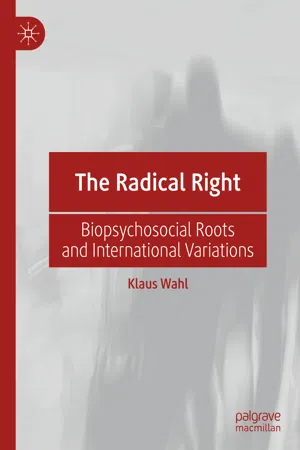The surge of xenophobia, nationalism, racism, authoritarianism, right-wing populism, and extremism in many countries aroused the interest of social and political scientists. Even natural sciences’ flagship journal
Nature has expressed worry about the nationalist surge:
Waves of nationalist sentiment are reshaping the politics of Western democracies in unexpected ways (…) Many economists see this political shift as a consequence of globalization and technological innovation over the past quarter of a century, which have eliminated many jobs in the West. And political scientists are tracing the influence of cultural tensions arising from immigration and from ethnic, racial and sexual diversity.” The long-running World Values Survey shows that people are increasingly disaffected with their governments and more willing to support authoritarian leaders. While the Nazis took advantage of the aftermath of World War I and a global depression, today’s populist movements are growing powerful in wealthy European countries with strong social programs. “What brings about a right-wing movement when there are no good reasons for it?” (Tollefson, 2016, p. 182)
Some authors locate the dissatisfaction with the democratic system (Foa & Mounk,
2017) in the larger development of a global recession of democracies since 2006 and a deepening of authoritarianism (Diamond,
2015). Could it be that racist and authoritarian attitudes and political preferences for populist right-wing parties have reached a critical mass in quite a number of countries, a tipping point, whereby sufficiently large minorities can change political cultures (Centola, Becker, Brackbill, & Baronchelli,
2018)? Others criticize this pessimistic view (Levitsky & Way,
2015).
For a long time, political science, history, sociology, psychology, and even biological sciences have tried to find obvious conditions, not so obvious preconditions, and deeper causes of these right-wing manifestations with divergent research paradigms and unconnected findings, which have resulted in questionable proposals for
prevention. Therefore, this book has several aims:
First, in view of the terminological confusion in the field of political, public, and scientific discourse on phenomena of the radical right (populism, radicalism, extremism, racism, etc.) will try some terminological clarifications (Chap. 1).
Second, in order to avoid simple theses such as “capitalism leads to fascism” or “Eastern Europe’s authoritarian socialism resulted in right-wing radicalism” the book tries to integrate the current findings of the historical, social, psychological, and biological sciences to explore the complex and deep roots of radical right-wing phenomena in a systematic way. Usually handbooks include research results of various disciplines unconnected in separate chapters. In contrast, this book attempts to show some connections between political, historical, sociological, psychological, and biological factors and mechanisms. The empirical findings of this vertical analysis shall fill a biopsychosociological model of the radical right. In so doing, this review not only focuses on the usual suspects like economic, social, and political factors, but also on pre-political factors causing psychosocial syndromes (e.g., xenophobia, authoritarianism) and their evolutionary roots and mechanisms that make people susceptible to radical right ideologies. Some processes between the different factor levels are reciprocal; therefore, no simple reductionist explanation of “higher” by “deeper” factors is sought. Such methodologically sophisticated studies on the development of right-wing radicalism in individuals and in general are usually carried out on limited populations in individual countries, cities, or universities. This approach is comparable to the “biopsychosocial model” in medicine (Needham et al., 2016), to evolutionary multi-level sociology (Bühl, 1982) and to the “depth-sociological” vertical integration of multi-level causes, mechanisms, and their interactions in social phenomena (Wahl, 2000). Of course, it is a long route from evolution and genes to political preferences or “the individual steps by which genetics connect to neurotransmitter systems which connect to cognitive and emotional processing tendencies which connect to values and personality traits which connect to orientations to bedrock principles which finally connect to preferences on specific political issues of the day” (Smith, Oxley, Hibbing, Alford, & Hibbing, 2011, p. 388). All these biotic and psychic processes are embedded in socio-economic and cultural environments (and their historical backgrounds), which function as triggers and catalysts of those processes. In addition, this review elucidates the radical right ideologies’ attractiveness for different personalities in different socio-economic and cultural situations. A better knowledge of this psychosocial “demand” for security and well-being, on the one hand, and the “supply” of radical right-wing ideologies and politicians promising security and easy solutions, on the other hand, could also inspire more effective prevention programs (Chaps. 2, 3 and 4).
Third, previous research was focused on political parties of the radical right. Social movements and the interaction between electoral politics and other forms of political mobilization (e.g., racist violence) have received relatively little attention (Muis & Immerzeel, 2017). Therefore, this book offers an international comparison of various political phenomena of the radical right (political parties, movements, groups, voters, prejudices, violence) in a horizontal perspective with foci on Western, Central, and Eastern Europe and the United States, their different histories, probable causes, and current developments. Such international comparisons are based on political opinion polls, election results, studies on the history, political systems, and political cultures of the countries, but they usually do not cover deeper individual psychological and biological factors (Chaps. 5, 6 and 7).
Fourth, the book will confront empirical research findings with some of the “usual suspects” of the causes of the radical right, which are frequently discussed in public: are the main culprits only “hard” factors such as globalization with the consequences of low wages, unemployment, or economic inequality? How important are “soft” factors like emotions, views of life, and cultural change? To what extent do objective and subjective aspects affect political processes? In addition, there are some short glances to other parts of the world and to the differences between the radical right and the radical left. Finally, the book offers—along the various levels of our biopsychosociological model—a sketch of possible approaches to political and pedagogical measures for the prevention of xenophobia and right-wing ideologies (Chap. 8).
